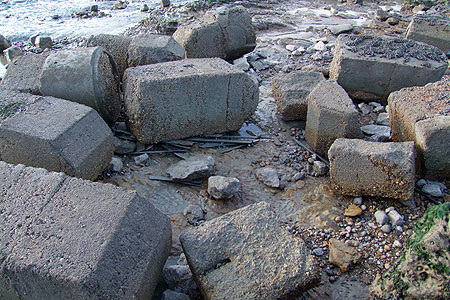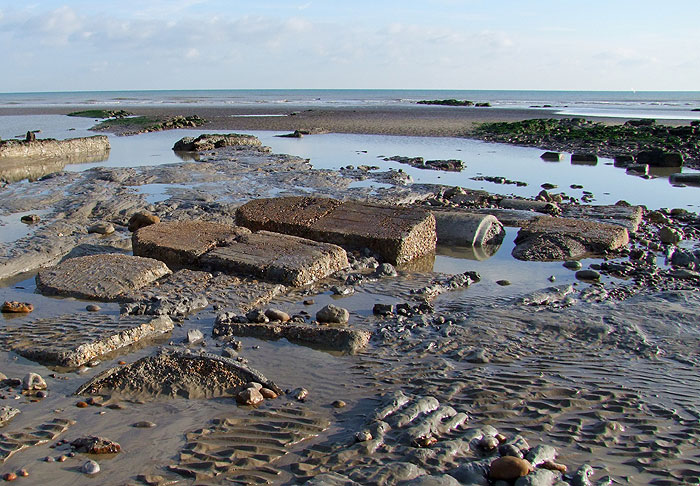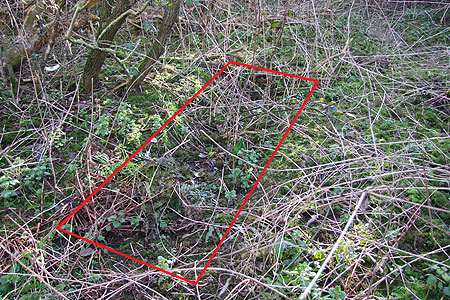Back at Bexhill
Posted: 7 February 2009 22:49
I returned to Bexhill today to reacquaint myself with the area; I ended up finding loads of cubes scattered on the beach and two slit trenches.
I've been a bit tired of late, so today's foray was the first fieldwork I've managed for a couple of weeks.
I've been quite active in and around Bexhill in the past, though aside from some roadblock work, it's been over a year since my last trip into the forward defended localities.

Making my way out to the Galley Hill - Glyne Gap area, I came across a large number of cubes on the beach; I estimate there are about 40 lying on the sands.
I believe these all came from a semi-circular line that protected the archway under the railway line 100m to the north.
An interesting feature is that two methods of 'root' construction have been employed; square wood-shuttering and circular concrete pipes.
The photo below shows how the cubes were subsequently used to bolster the coastline against sea erosion; a causeway of uprooted blocks have been arranged in a gap in the natural rock to stem the advance of the tide.

Although I had previously seen the large outcrop of cubes, I'd not seen this patio of cubes before; it certainly proves that uprooted cubes were not always randomly dumped on the sands for the sea to deal with.

But the find of the day was two slit trenches and a possible third; a return visit is needed to confirm the latter as a trench (or not).
I had previously known from documents that there were slit tenches in this area, but had failed to locate them. The construction of flats, the demolition of Sackville Lodge (a house that stood to the west of the coastguard tower) and the plethora of manhole covers in the area indicate wholesale landscape change in the immediate area that lead you to believe that you wouldn't still be able to see evidence of trenches at this spot.
However, a year down the line and much experience of identifying Downsforce trenches under my belt, these two stood out.
The possible third trench was a little way off, although in logical arrangement with the others. Once I've analysed the data (orientation and relation) I may be in a better position to identify it or discard it from my records.
Bexhill is a fascinating area and perhaps the best documented; at the time of writing, the town tops my Documentary Evidence database list with 138 recorded defence and occupation works. (This doesn't mean Bexhill had the most works in East Sussex; my stats are based on my progress with entering data into the database as well as the amount of available documents; Rye and Newhaven will also be vying for first place because documentary evidence concerning them has survived, but not yet databased.)
I have good construction information, a detailed defence scheme, numerous war diaries and some regimental journals that provide fascinating platoon gossip (was a sergeant in the Galley Hill platoon an early riser, or was he just arriving back after spending the night elsewhere? Why was there a lady's bicycle in the platoon's stores?)
Let's not forget the Roadblock report that indicates that Bexhill had more roadblocks than any other area in the East Sussex Divisional Area, another document lists all of the permanent street barricades and then we have the German intelligence documents for the area; I already have enough information to write a hefty volume on this one town!
As a result of all this information, I've decided to continue researching Bexhill as a project, although I've not had time to knock up the project outline pages yet - keep watching this space!
- Pete

Email:
Blog Latest

Bishopstone reveals its pillbox secrets
18 October 2021

Pillbox or Observation Post?
10 June 2020

Uncovering the hidden secrets of a pillbox
8 June 2019

Review of 2018
31 December 2018

Wartime Christmas in East Sussex (2)
24 December 2018
Jargon-buster
Cubes
Anti-tanks blocks, popularly known as dragon's teeth. Not to be confused with smaller blocks known as pimples, cubes can be upwards of 1m square. Many examples in Sussex have apexes or chamfered edges, leading to them being incorrectly recorded as coffins.
Defence scheme
A military plan of defence for a specified area. Defence Schemes were issued at numerous levels. Defence Schemes were later known as Plans to Defeat Invasion on the orders of General Montgomery.
Demolition
Term applied to a structure scheduled for demolition or already demolished. Walls and small buildings might be taken down to clear fields of fire or impede enemy passage by destroying a bridge. Some demolitions were not intended to be carried out until after invasion had begun, for example, certain bridges or road craters (pipe mines).
Slit trench
Small, narrow trench designed to provide protection against shrapnel and other battlefield hazards. Technically distinct from a weapon pit (which was intended soley as a defensive position) slit trenches were also used as defence works.
This site is copyright © Peter Hibbs 2006 - 2024. All rights reserved.
Hibbs, Peter Back at Bexhill (2024) Available at: http://pillbox.org.uk/blog/216604/ Accessed: 27 July 2024
The information on this website is intended solely to describe the ongoing research activity of The Defence of East Sussex Project; it is not comprehensive or properly presented. It is therefore NOT suitable as a basis for producing derivative works or surveys!